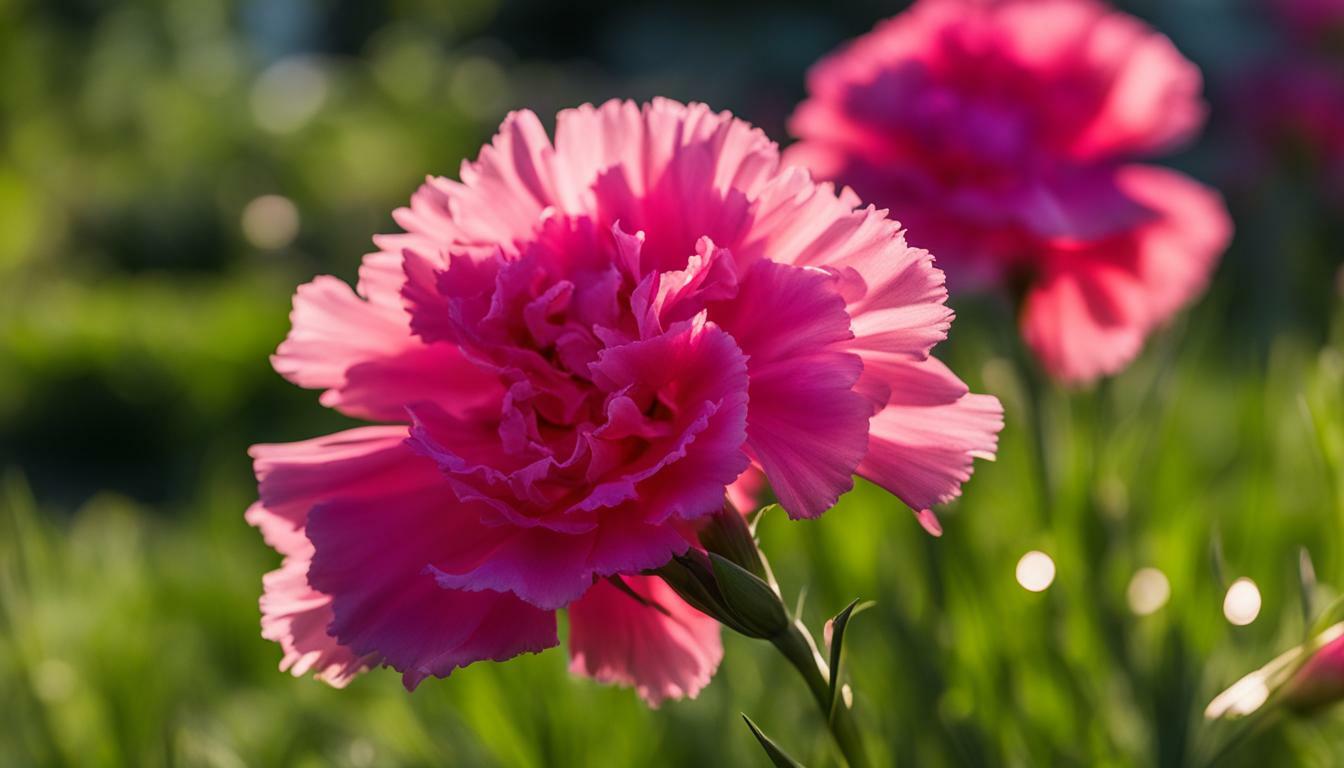
If you want your garden to be filled with vibrant and colorful carnations, it’s essential to understand the best practices for carnation care. Carnations are easily grown in gardens and are popular as cut flowers. They bloom from late spring to midsummer, with the flowering season extended through regular deadheading. Carnations come in various colors and feature a spicy-sweet fragrance. T
hey form spreading clumps with narrow, glaucous or blue-green foliage. Carnations are attractive to bees, butterflies, and other pollinators. They can be dried for potpourri or pressed for art projects. Carnations are herbaceous perennials that grow in clumps or mats. Carnation cultivation dates back to ancient Greek and Roman times. Carnations can be propagated by root division, seed, or stem cuttings. Root division and stem cuttings are common propagation methods. Carnations require well-drained soil and full sun to thrive.
Care includes proper spacing, watering in the morning, and providing support for taller varieties. Carnations can be prone to pests such as aphids, spider mites, and cutworms. Fungal diseases like leaf spot, rust, and botrytis flower rot can affect carnations. Carnations can be grown from seed or cuttings. Carnation blooms can be encouraged to open by brushing or gently squeezing the buds. Carnations are easy to care for and produce a lot of flowers with little effort.
- Carnations are popular as cut flowers and bloom from late spring to midsummer.
- They come in various colors and have a spicy-sweet fragrance.
- Proper care includes well-drained soil, full sun, and providing support for taller varieties.
- Carnations can be propagated by root division, seed, or stem cuttings.
- They are prone to pests and diseases, so regular monitoring and prevention are important.
Understanding Carnations and Their Varieties
Carnations are versatile plants with various colors and a distinct spicy-sweet fragrance, making them an attractive addition to any garden. These beautiful flowers come in a wide range of varieties, each with its own unique characteristics and care requirements. Understanding the different types of carnations can help you choose the right ones for your garden and ensure their proper care.
One popular variety is the Standard Carnation, also known as the Spray Carnation. These carnations have multiple blooms per stem, making them perfect for creating full and abundant floral arrangements. They come in a variety of colors, including classic red, pink, white, and yellow.
Another popular variety is the Dianthus caryophyllus, known as the Border Carnation. These carnations are characterized by their fringed petals and strong fragrance. They bloom in a range of colors, from pastel hues to vibrant shades, and are ideal for border plantings, rock gardens, or as cut flowers.
The Chabaud Carnation, also known as the Perpetual Flowering Carnation, is another popular choice. These carnations bloom continuously throughout the summer, providing a constant display of beautiful flowers. They come in a range of colors and are perfect for adding color and fragrance to your garden.
| Variety | Characteristics |
|---|---|
| Standard Carnation | Multiple blooms per stem, wide range of colors |
| Border Carnation | Fringed petals, strong fragrance, ideal for borders or as cut flowers |
| Chabaud Carnation | Continuous blooming, various colors, adds color and fragrance to gardens |
When choosing carnations for your garden, consider the specific care requirements of each variety. Some carnations may prefer full sun, while others thrive in partial shade. Additionally, certain varieties may require more water or specific soil conditions for optimal growth. By selecting the right carnation varieties and providing them with the care they need, you can enjoy a stunning display of colorful blooms in your garden.

“Carnations are not only beautiful, but they also have a rich history and cultural significance. They have been cultivated since ancient times and are often associated with love, femininity, and Mother’s Day. Whether you’re a seasoned gardener or a beginner, growing carnations in your garden is a rewarding and enjoyable experience.” – Horticulture Expert
The History and Significance of Carnations
Carnations have a rich history dating back to ancient times, where they were prized for their beauty and fragrance. Cultivation of carnations can be traced back to the ancient Greeks and Romans, who cultivated these flowers for use in religious ceremonies, as well as for their ornamental value. The popularity of carnations spread throughout Europe during the Middle Ages, where they were commonly used as decorative elements in garlands and wreaths.
In addition to their aesthetic appeal, carnations also hold symbolic significance. These flowers have been associated with love and fascination, making them a popular choice for gifts and celebrations. In fact, in many cultures, carnations are often given on Mother’s Day as a token of gratitude and admiration for maternal figures. The color of the carnation can also convey different meanings, with pink representing love and red symbolizing deep affection.
Carnation propagation methods have evolved over time, with root division and stem cuttings being the most common techniques used today. Root division involves separating the clumps of carnations and replanting them, while stem cuttings involve taking cuttings from healthy stems and rooting them in soil or water. These propagation methods allow for the easy multiplication of carnations, making it accessible for gardeners to grow these beautiful flowers in their own gardens.
To ensure successful cultivation of carnations, it’s important to provide them with optimal growing conditions. Carnations thrive in well-drained soil and require full sun exposure to bloom abundantly. Proper spacing between plants is also essential to allow for adequate air circulation and prevent the spread of diseases. In terms of care, watering in the morning and providing support for taller varieties can help promote healthy growth and prevent damage to the stems.
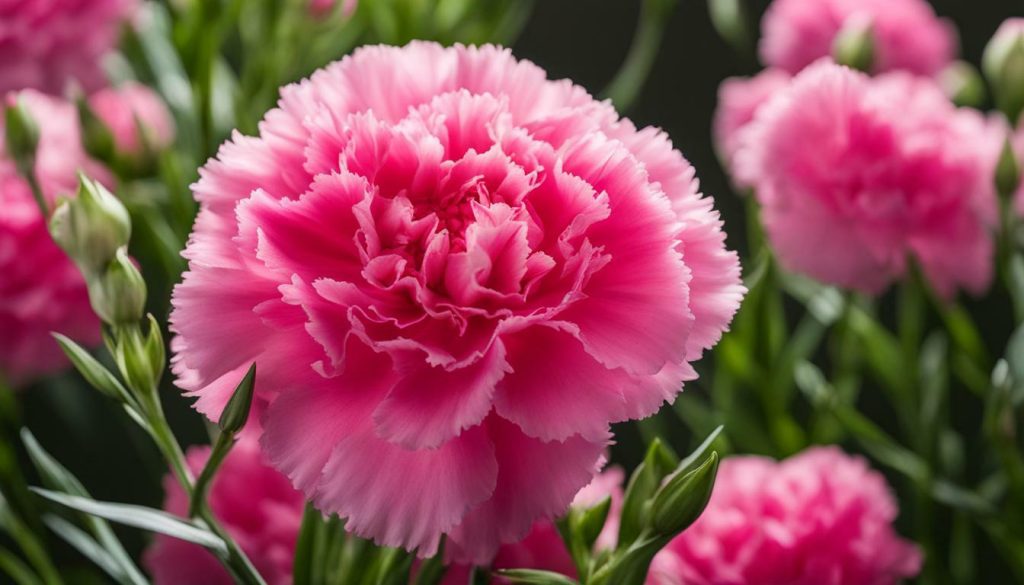
| Key Points | Benefits |
|---|---|
| Rich history dating back to ancient times | Connects us to our cultural heritage |
| Symbolic significance | Expresses emotions and sentiments |
| Propagation methods | Allows for easy multiplication |
| Optimal growing conditions | Promotes healthy growth and abundant blooms |
Essential Growing Conditions for Carnations
To ensure healthy growth and abundant blooms, carnations need specific growing conditions that cater to their needs. These beautiful flowers thrive in well-drained soil and require full sun exposure. It is essential to choose a planting location that receives at least 6-8 hours of direct sunlight each day. The soil should be rich in organic matter and have a pH level between 6.0 and 7.0 for optimal growth.
Carnations should be spaced adequately to allow proper airflow and prevent overcrowding. The recommended spacing between plants is around 12 inches apart, which allows enough room for them to spread and develop. Additionally, providing support for taller carnation varieties is crucial. This can be achieved by using stakes or trellises, which help prevent the plants from bending or breaking under their own weight.
When it comes to watering, carnations prefer a moderate amount of moisture. It is best to water them in the morning, as this allows the foliage to dry throughout the day and reduces the risk of diseases. Watering should be done at the base of the plants, avoiding wetting the leaves. This helps prevent issues such as leaf spot or botrytis flower rot, which thrive in humid conditions.
| Growing Conditions | Carnations |
|---|---|
| Soil | Well-drained, pH 6.0-7.0 |
| Exposure | Full sun (6-8 hours/day) |
| Spacing | 12 inches apart |
| Support | Stakes or trellises for taller varieties |
| Watering | Moderate moisture, water in the morning |
Essential Growing Conditions for Carnations
“Well-drained soil, full sun exposure, proper spacing, and adequate support are essential for the healthy growth of carnations.” – Expert Gardener
In summary, providing the right growing conditions for carnations is crucial for their overall health and blooming potential. From well-drained soil and ample sunlight to proper spacing and support, each factor plays a vital role in ensuring these beautiful flowers thrive in your garden.
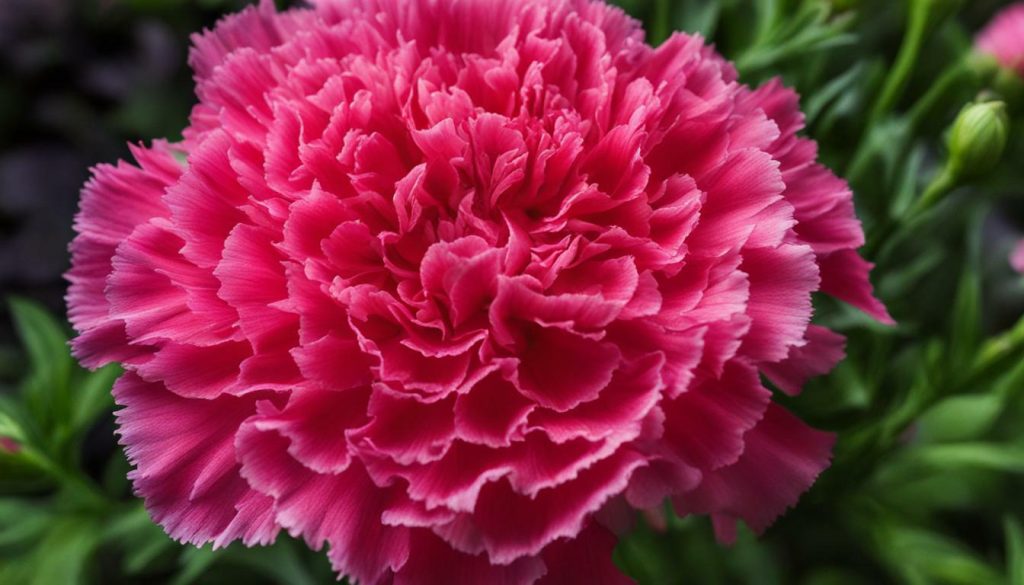
Watering and Fertilizing Carnations
Adequate watering and timely fertilization are essential for maintaining the health and vitality of your carnations. These beautiful flowers require consistent moisture, but be careful not to overwater as this can lead to root rot. It is best to water in the morning, allowing the foliage to dry throughout the day, which helps prevent fungal diseases.
When watering your carnations, aim to keep the soil evenly moist but not waterlogged. Use your finger to check the moisture level in the soil and water when the top inch feels dry. Remember, it’s better to water deeply and infrequently rather than giving your plants frequent shallow waterings.
Fertilizing your carnations regularly will provide them with the nutrients they need for healthy growth and abundant blooms. Use a balanced, slow-release fertilizer or a water-soluble fertilizer formulated specifically for flowering plants. Follow the manufacturer’s instructions for application rates and frequency.
| Watering Tips: | Fertilizing Tips: |
|---|---|
| – Water in the morning, allowing foliage to dry throughout the day | – Use a balanced, slow-release fertilizer |
| – Keep soil moist but not waterlogged | – Choose a water-soluble fertilizer for flowering plants |
| – Check soil moisture regularly and water when the top inch feels dry | – Follow manufacturer’s instructions for application rates and frequency |
“Proper watering and fertilization are key to ensuring strong and healthy carnation plants. By providing adequate moisture and nutrients, you can enjoy an abundant display of vibrant blooms.” – Gardening Expert
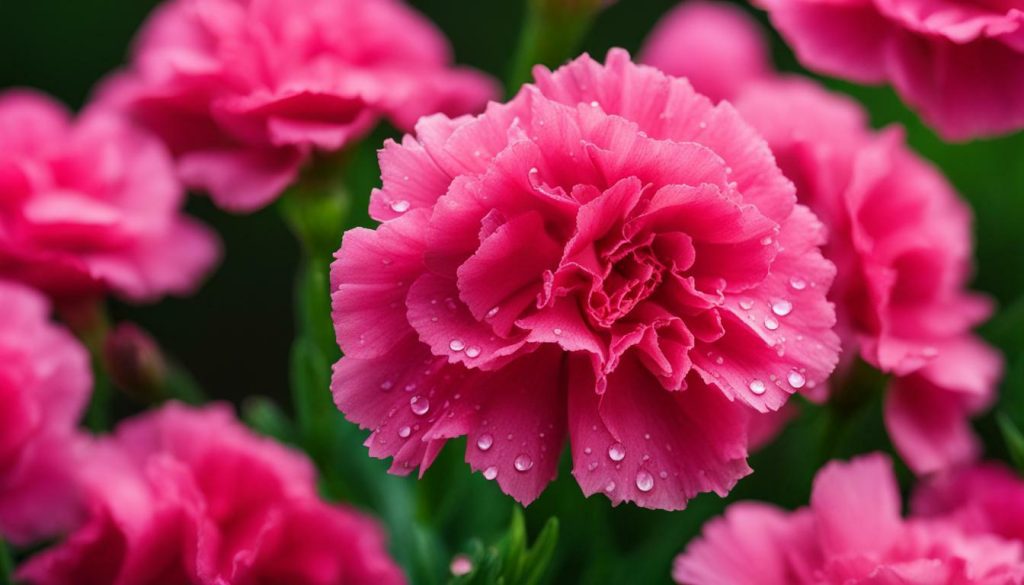
Adequate watering and timely fertilization are essential for the health and vitality of your carnations. Water your carnations in the morning, keeping the soil moist but not waterlogged, and fertilize regularly with a balanced, slow-release or water-soluble fertilizer. Remember to check soil moisture regularly and follow the manufacturer’s instructions for fertilization. By implementing these best practices, your carnations will thrive and reward you with beautiful, vibrant blooms.
Dealing with Pests and Diseases
Like any other plant, carnations can be susceptible to pests and diseases that can affect their growth and overall health. It is essential to be proactive in identifying and addressing these issues to ensure a thriving garden. Here are some common pests and diseases that can affect carnations and best practices for dealing with them:
Aphids
Aphids are small, soft-bodied insects that feed on the sap of plants, including carnations. They can cause curling leaves, stunted growth, and the presence of sticky residue known as honeydew. To control aphids, you can spray the affected plants with a mixture of water and mild dish soap or use an insecticidal soap. Encouraging natural predators like ladybugs can also help keep aphid populations in check.
Spider Mites
Spider mites are tiny pests that often appear as small red or brown specks on the undersides of leaves. They feed by piercing the plant tissue and sucking out the sap, resulting in yellowing, speckled leaves, and webbing. To control spider mites, you can spray the plants with a strong jet of water to dislodge them or use insecticidal soap or neem oil. Regularly misting the plants can also help prevent spider mite infestations.
Fungal Infections
Carnations can be susceptible to various fungal infections, such as leaf spot, rust, and botrytis flower rot. These diseases can cause discoloration, spots, and wilting of leaves and flowers. To prevent fungal infections, it is crucial to provide adequate air circulation by spacing the plants properly and avoiding overhead watering. Applying a fungicide approved for ornamental plants can help control and prevent fungal diseases. Removing and destroying infected plant material can also help stop the spread of the infection.
By staying vigilant and taking proactive measures, you can effectively manage pests and diseases that may affect your carnations. Regular monitoring, proper cultural practices, and timely intervention can help ensure healthy and vibrant carnations in your garden.
| Pest/Disease | Symptoms | Treatment |
|---|---|---|
| Aphids | Curling leaves, stunted growth, honeydew | – Spray with water and mild dish soap – Use insecticidal soap – Encourage natural predators |
| Spider Mites | Yellowing, speckled leaves, webbing | – Spray with water to dislodge – Use insecticidal soap or neem oil – Mist plants regularly |
| Fungal Infections | Discoloration, spots, wilting | – Provide proper spacing and air circulation – Avoid overhead watering – Apply approved fungicide – Remove and destroy infected plant material |
Remember, prevention is key when it comes to managing pests and diseases in your carnations. Regular inspection and early detection can help you keep your plants healthy and blooming.
“By staying vigilant and taking proactive measures, you can effectively manage pests and diseases that may affect your carnations.”

Propagation Techniques for Carnations
If you want to expand your carnation collection or share your plants with others, learning how to propagate carnations is essential. Luckily, there are several methods you can use to propagate these beautiful flowers, including root division, seed propagation, and stem cuttings.
Root division is a popular and straightforward method. Start by carefully lifting the carnation clump from the ground, and then gently separate the roots into smaller sections. Each section should have its own set of roots and shoots. Replant these divisions in a well-prepared soil mix, making sure to keep them well-watered until they establish themselves.
Seed propagation requires a bit more patience but can be rewarding. Collect seeds from mature carnation flowers and sow them in a tray or pot filled with a well-draining seed-starting mix. Keep the soil consistently moist and place the tray in a sunny location. Within a few weeks, you should see seedlings sprouting. Allow them to grow for a few months before transplanting them into individual pots or directly into the garden.
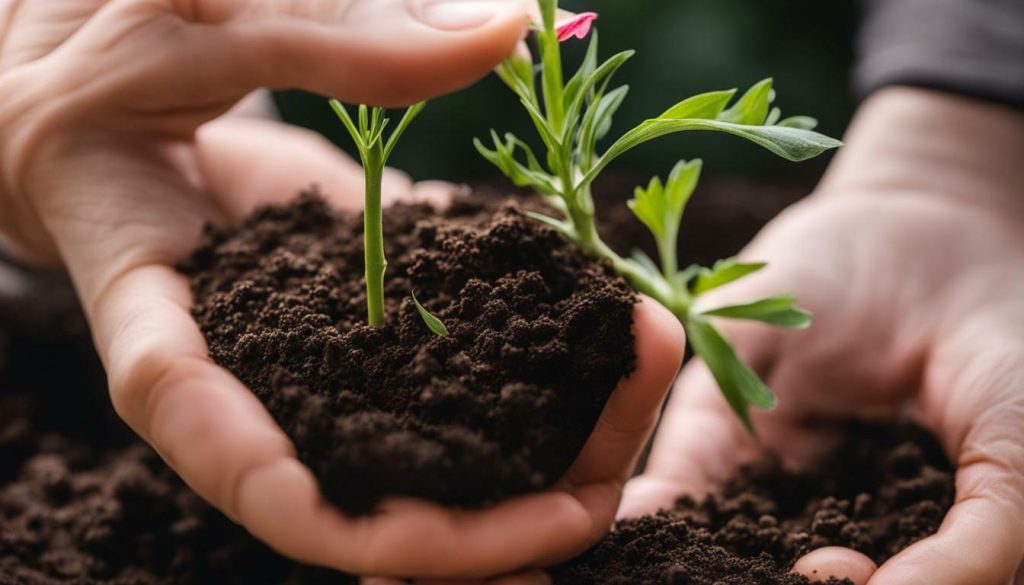
Stem cuttings are another effective way to propagate carnations. Select a healthy non-flowering stem and cut it just below a leaf node. Remove any lower leaves, leaving only a few sets of leaves at the top. Dip the cut end into a rooting hormone and insert it into a pot filled with a moist soil mix. Keep the cutting in a warm and humid environment to encourage root growth. Once roots have formed, you can transplant the cutting into a larger pot or directly into the garden.
By learning and practicing these propagation techniques, you can easily multiply your carnation collection and share the beauty of these flowers with others. Experiment with different methods to find the one that suits you best, and soon you’ll have a flourishing garden filled with vibrant carnations.
Harvesting and Preserving Carnations
Knowing when and how to harvest your carnations and preserve their beauty can allow you to enjoy their blooms even longer. Carnations are known for their long-lasting flowers, and with proper care, you can make the most of their vibrant colors and delicate fragrance.
When it comes to harvesting carnations, timing is essential. Wait until the buds are fully open but not fully bloomed to ensure maximum freshness. Using a sharp pair of garden shears, cut the stems at a 45-degree angle, about 1 inch from the base of the plant. Avoid cutting too close to the main stem to avoid damaging the plant.
Once you’ve harvested your carnations, it’s time to preserve them. One popular method is air drying. Bundle the stems together and hang them upside down in a dry, well-ventilated area away from direct sunlight. This allows the flowers to dry naturally, preserving their shape and color. After a few weeks, your carnations will be fully dried and ready for use in crafts, potpourri, or arrangements.

If you prefer to preserve your carnations as cut flowers, there are a few tricks to extend their vase life. Start by filling a clean vase with fresh water and adding floral preservative or a homemade solution of water, lemon juice, and a teaspoon of sugar. Remove any leaves that will be submerged in the water to prevent bacterial growth.
Trim the stems at a 45-degree angle before placing them in the vase. Change the water every two to three days and recut the stems to ensure optimal hydration. Keep the vase away from direct sunlight and drafts to prevent wilting. With proper care, your cut carnations can last up to two weeks, brightening up your home with their beauty.
| Harvesting Tips | Preservation Tips |
|---|---|
| Wait for fully open but not fully bloomed buds | Hang upside down in a dry, well-ventilated area for air drying |
| Cut stems at a 45-degree angle with sharp garden shears | Remove leaves submerged in water to prevent bacterial growth |
| Avoid cutting too close to the main stem | Change water every two to three days for cut flowers |
| Keep vase away from direct sunlight and drafts |
Conclusion: Effortless Carnation Care for a Blooming Garden
With the right care and attention, carnations can thrive in your garden, providing stunning blooms and a delightful fragrance all season long. These versatile and beautiful flowers are easily grown in gardens and make excellent cut flowers. By following a few simple tips, you can ensure the health and longevity of your carnations, creating a vibrant and colorful garden.
Carnation care starts with choosing the right location for planting. These herbaceous perennials prefer well-drained soil and full sun to thrive. Make sure to provide adequate spacing between plants to allow for air circulation and prevent overcrowding. Watering in the morning will promote healthy growth and help prevent diseases.
Support is essential, especially for taller varieties. As your carnations grow, provide stakes or trellises to keep them upright and prevent bending or breaking. Regular deadheading, the removal of faded flowers, will encourage continuous blooming and extend the flowering season.
While carnations are generally hardy, they can encounter pests and diseases. Aphids, spider mites, and cutworms are common nuisances, but can be controlled through organic methods or insecticidal soaps. Fungal diseases like leaf spot, rust, and botrytis flower rot can be prevented by keeping the foliage dry and providing good air circulation.
With their variety of colors and spicy-sweet fragrance, carnations are sure to add beauty to your garden. Whether you choose to grow them from seeds or cuttings, these lovely flowers will reward you with abundant blooms and minimal effort. So go ahead, plant some carnations and enjoy a blooming garden filled with vibrant colors and captivating scents.
FAQ
Q: How long do carnations bloom for?
A: Carnations bloom from late spring to midsummer, with the flowering season extended through regular deadheading.
Q: What colors do carnations come in?
A: Carnations come in various colors, including red, pink, white, yellow, and purple.
Q: Do carnations have a fragrance?
A: Yes, carnations have a spicy-sweet fragrance.
Q: How do you propagate carnations?
A: Carnations can be propagated by root division, seed, or stem cuttings.
Q: What are the ideal growing conditions for carnations?
A: Carnations require well-drained soil and full sun to thrive.
Q: How often should I water my carnations?
A: It is recommended to water carnations in the morning and ensure they receive about 1 inch of water per week.
Q: What pests and diseases are common for carnations?
A: Carnations can be prone to pests such as aphids, spider mites, and cutworms. They can also be affected by fungal diseases like leaf spot, rust, and botrytis flower rot.
Q: How can I preserve carnations?
A: Carnations can be dried for potpourri or pressed for art projects. To extend their blooming season, regularly deadhead the spent flowers.
Q: Are carnations easy to care for?
A: Yes, carnations are easy to care for and produce a lot of flowers with little effort.
A renowned botanist and author of “Blossoming Wonders,” Dr. Desai has dedicated his life to studying the intricate behaviors of plants, especially exotic flowers. His research has led to breakthroughs in sustainable cultivation practices.


